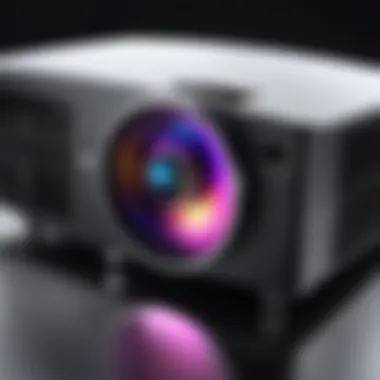Ultimate Guide to Choosing the Best Video Projector


Intro
Choosing an optimal video projector requires careful consideration of several factors. This task may seem technical at first glance, but understanding the underlying principles can greatly improve your audiovisual experience. With numerous models on the market, distinguishing between them goes beyond mere brand recognition. This guide is tailored for IT professionals and tech enthusiasts who seek to navigate the complexities of projector specifications, functionalities, and application scenarios.
Features Overview
When selecting a video projector, several key specifications must be evaluated to suit your intended use. These specifications will inform you about the projector's capabilities and limitations, making it easier to align your choice with your unique needs.
Key Specifications
- Resolution: The clarity of the display hinges on the resolution. Common choices include 720p, 1080p, and 4K. Higher resolutions produce more detailed images, suitable for presentations or cinematic experiences.
- Brightness: Measured in lumens, brightness affects performance in various lighting conditions. A projector with lower lumens may only be effective in dark environments while brighter projectors can operate efficiently under ambient light.
- Contrast Ratio: This factor determines the difference between the brightest and darkest parts of an image. A higher contrast ratio results in deeper blacks and more vivid colors, enhancing overall visual quality.
- Connectivity Options: Modern projectors offer multiple options like HDMI, USB, and wireless connections. These facilitate compatibility with various devices, such as laptops, smartphones, and streaming devices.
Unique Selling Points
Proven features set some projectors apart. Look for models that promise exceptional color accuracy, integrated speakers, and portable designs. These attributes can significantly enhance usability.
- Portability: For presentations on the go, weigh the weight and size of the projector. Mini projectors are lightweight and easy to transport.
- Integrated Speakers: Some models include built-in audio systems, which may suffice for smaller environments, limiting the need for extra equipment.
Key Takeaway: Each specification plays a crucial role in determining how well a projector will serve its purpose, whether for professional presentations or home theaters.
Performance Analysis
Analyzing performance requires examining benchmarks and how projectors fare in real-world scenarios. This evaluation yields insight into their capabilities and reliability.
Benchmarking Results
When comparing different projectors, benchmarking tests assess attributes such as brightness efficiency and color reproduction. Industry-standard tests often include:
- Color accuracy measurements
- Brightness under varying lighting conditions
- Heat generation during prolonged use
These benchmarks help in defining a projector's overall performance and usability across different environments.
Real-world Scenarios
Practical usage scenarios can provide actual insight into how a projector performs. Consider the following:
- Home Theater: A high-resolution, high-contrast projector in a dark room offers an immersive viewing experience for movies.
- Business Presentations: A bright projector with multiple connectivity options is ideal for meetings in well-lit conference rooms.
Understanding these variables enhances informed decision-making when choosing a projector. Evaluating specifications in tandem with performance can uncover the best option tailored to your specific needs and environment.
Understanding Video Projectors
In the age of digital media, understanding video projectors is crucial for anyone seeking to elevate their visual experience. By grasping the fundamental aspects of projectors, users can make informed choices tailored to their specific needs. This section lays the groundwork by delving into the definition and functionality of video projectors, as well as categorizing the various types available on the market. These insights not only facilitate better purchasing decisions but also enhance the overall comprehension of how projectors can be integrated into different environments.
Definition and Functionality
A video projector is an optical device that projects images or videos onto a surface, typically a screen or wall. The main functionality hinges on the input of video signals, which are processed and transformed into visual display. The image is created using various technologies, with each type contributing unique advantages and disadvantages to the quality of the projected image.
Understanding the basic operation of video projectors is vital. It allows users to recognize how factors like resolution and brightness impact the viewing experience. This knowledge empowers individuals to select the right projector suited to their intended usage, whether for personal, educational, or professional contexts.
Types of Video Projectors
The market offers a wide range of projector types, each engineered to meet diverse requirements and preferences. Recognizing the distinctions between these types is essential for making an educated decision. The primary types include:
Projectors
LCD projectors utilize liquid crystal display technology to generate images. They are known for their vibrant colors and sharp image quality. The key characteristic of LCD projectors is their excellent color reproduction, making them a preferred choice for vibrant presentations. Additionally, their ability to maintain image quality under various lighting conditions showcases their versatility.
Unique features of LCD projectors include:
- High brightness levels that cater well to environments with ambient light.
- Longer lifespan compared to some alternatives.
However, they have disadvantages. For instance, the potential for pixelation in large images may deter some users.
DLP Projectors
DLP projectors operate using a Digital Light Processing chip that features micro-mirrors for image creation. One of their most significant contributions is the smoother motion in videos, ideal for cinematic experiences. This smooth performance is a distinct benefit when using this type of projector for movies or fast-paced presentations.


Key characteristic of DLP projectors:
- Generally, they have a higher contrast ratio, which enhances the depth of the image.
The unique feature of DLP projectors includes their compact size. This portability makes them suitable for situations where space-saving is important. However, some models may experience the “rainbow effect,” which can affect viewer experience.
LED Projectors
LED projectors utilize light-emitting diodes as a light source. One significant advantage of LED projectors is their energy efficiency and longer lifespan compared to traditional lamps. This longevity not only reduces maintenance costs but also has a positive impact on environmental concerns.
Key characteristic of LED projectors:
- They generally produce higher-quality images in dark environments.
Although LED projectors are compact and portable, they may struggle with brightness levels in bright rooms. Therefore, understanding the setting in which they will be used is critical.
Laser Projectors
Laser projectors are gaining popularity due to their reliability and quick start-up times. The use of lasers allows for incredibly bright and high-contrast images. This type is particularly beneficial in large venues or settings where clarity and brightness are paramount.
Key characteristic of laser projectors:
- Exceptional color accuracy and brightness, allowing for stunning visuals in a variety of conditions.
On the downside, laser projectors may come with a higher initial cost. This aspect can be a limiting factor for some users. Understanding these key attributes and limitations leads to better decisions that enhance audiovisual experiences in various settings.
"Understanding the technical aspects of video projectors significantly improves decision-making, ensuring the right choice for any environment."
In summary, this overview illustrates how grasping the definitions and various types of video projectors is essential in evaluating and selecting the right model to meet specific audiovisual demands.
Key Specifications to Consider
When evaluating a video projector, understanding the key specifications is crucial. These specifications can affect not only the quality of the image but also how well a projector meets your specific needs. Choosing the right projector can enhance your audiovisual experiences significantly. Factors like resolution, brightness, contrast ratio, and connectivity are often overlooked yet play critical roles in ensuring performance and user satisfaction.
Resolution and Image Quality
Definition of Resolution
Resolution refers to the number of individual pixels that make up the projector's image. Typically described in width x height format (for example, 1920x1080), higher resolutions generally lead to sharper and clearer images. Understanding resolution helps consumers determine the visual fidelity they can expect and is fundamental to the overall goal of achieving high-quality projection. A projector with a higher resolution allows for larger displays without losing clarity, making it beneficial for situations that require detailed images, such as presentations or home theaters.
Common Resolutions Explained
Common resolutions include standard formats such as VGA, HD, Full HD, 4K, and 8K. Each of these serves different purposes and environments. For instance, Full HD (1920x1080) is popular for home theaters, while 4K (3840x2160) has gained momentum among professional users due to its superb detail. Knowing which resolution corresponds to your specific needs is essential; while higher resolutions offer more detail, they also necessitate better supporting equipment.
Impact on Quality of Projection
The impact of resolution on image quality is substantial. A higher resolution projector can project images that maintain detail even at large sizes, reducing pixelation. However, the contrast between resolution and the quality of the source material must be considered. If the source resolution is lower than the projector's capabilities, users may not see the benefits of their higher investment. This understanding helps in selecting a projector that aligns with both the source content and the desired display size.
Brightness Measurement
Lumens Explained
Brightness is measured in lumens and indicates how much light a projector emits. A higher lumen rating usually translates to brighter images, which is particularly important in well-lit environments. Understanding lumens is critical when choosing a projector for various settings; a projector used for home cinema may not need as many lumens as one intended for a corporate meeting room.
Importance for Indoor vs. Outdoor Use
The importance of brightness varies significantly between indoor and outdoor environments. Projectors used in outdoor settings typically require higher lumens due to ambient light. Conversely, indoor projectors can often perform well with lower brightness levels. Thus, determining the primary usage environment affects brightness requirements significantly.
Evaluating Required Brightness
Evaluating the required brightness involves analyzing the intended viewing conditions. Factors like wall color, ambient light, and screen size come into play. Users may need around 1000 to 2000 lumens for close indoor setups, while outdoor projections might demand upwards of 3000 lumens. A careful approach to brightness selection enhances clarity and prevents eye strain during extended use.
Contrast Ratio
Understanding Contrast Ratio


The contrast ratio measures the difference between the darkest and lightest parts of the image. A higher contrast ratio can yield deeper blacks and brighter whites, which are crucial for image depth and realism. Understanding contrast ratio is essential for identifying how it performs across various environments and its relevance to the overall image quality.
How it Affects Detail and Clarity
Higher contrast ratios positively impact detail and clarity. For instance, a projector with a 3000:1 contrast ratio will display more detail in shadows compared to a 1000:1 ratio. This factor is particularly beneficial for films or content with dark scenes. Therefore, evaluating contrast ratios is important in selecting a projector that offers vibrant, clear images suitable for specific viewing environments.
Choosing the Right Ratio for Your Environment
Choosing the right contrast ratio involves considering the viewing environment and the content type. For general use, such as office presentations, standard contrast ratios work well. However, for dedicated home theater setups, a higher contrast ratio enhances viewer experience. In this context, users should align their choice with their viewing habits and content types to ensure the best experience.
Connectivity Options
HDMI and Other Input Types
HDMI is the standard for modern video projectors. It supports high-definition video and audio in one cable, simplifying connections with devices. Other inputs like VGA or component ports might still be required in some legacy systems, depending on the devices involved. The variety of input types is a significant concern that can dictate equipment integration.
Wired vs. Wireless Connections
Wired connections typically provide stable signals without latency issues, which is beneficial for gaming or live presentations. Wireless options, while convenient, may introduce delays, which might not be ideal for all scenarios. Understanding the pros and cons of each connection type is vital for assessing what best fits your requirements, as certain events may not tolerate connection interruptions.
Adaptability for Multiple Devices
Adaptability for multiple devices refers to a projector's capacity to connect with various input sources. This feature is particularly important in shared environments like classrooms or conference rooms. A projector that can connect to a computer, smartphone, or streaming device improves usability. Understanding this adaptability allows buyers to select a suitable model for diverse configurations and usage scenarios.
Usage Scenarios
Understanding the various usage scenarios for video projectors is crucial. Each environment presents unique needs and challenges that can greatly affect the choice of the projector. Recognizing these scenarios helps in making informed decisions that align with the intended application. Choosing the appropriate projector ensures optimal performance and viewer experience, whether for home entertainment, business presentations, educational purposes, or events.
Home Theater Setups
Home theater setups create a cinematic atmosphere in the comfort of one's own home. When selecting a projector for this application, several considerations are important. Image quality is paramount. Home theaters often benefit from projectors with higher resolutions, such as 4K, to enhance detail and immersion.
Another factor is the ambiance of the room. Darker environments can leverage projectors with lower brightness ratings to create deep blacks and vivid colors. Additionally, the size of the screen must match the projector's capabilities, usually requiring a short-throw projector in smaller spaces.
Lastly, integration with audio systems adds to the experience, making connectivity options vital. Consider projectors that support HDMI and can interface with surround sound setups.
Office and Conference Room Applications
Office projectors must deliver clarity and professionalism. Here, brightness and resolutions play significant roles. High-lumen projectors are essential for well-lit conference rooms, especially during presentations. For effective collaboration, projectors with multiple connectivity options allow easy switching between laptops and other devices.
Furthermore, projectors that support wireless technology can reduce cable clutter, streamlining the setup process. Features like interactive capabilities can also provide dynamic presentations that engage viewers.
Educational Environments
In educational institutions, projectors serve diverse functions. They may be used for lectures, presentations, or collaborative learning. Educational projectors should ideally provide adequate brightness and sharpness to ensure visibility from different portions of a classroom.
Durability and ease of use are also important, as projectors frequently moved between rooms. Some models include features that facilitate easy installation and alignment, which can save valuable time during transitions. Advanced connectivity options, including support for tablets and laptops, can foster inclusive learning experiences.
Public Displays and Events
Projectors employed in public displays or events necessitate robustness. These environments demand high brightness levels to compete with ambient light, especially outdoors. Renting projectors for temporary setups may also become common. Therefore, following the latest technology trends, such as outdoor laser projectors, is wise.
They should possess multiple inputs for easy use with various media player devices and systems. The ability to manage larger screen sizes is also essential for ensuring visibility in larger crowds. Overall, selecting projectors for events requires careful consideration of intended use and environmental conditions.
"A projector optimized for its environment can significantly enhance the audience's experience and engagement."
Comparative Analysis of Popular Models
In the quest for the ideal video projector, understanding the landscape of available options is essential. A comparative analysis of popular models enables readers to navigate through the myriad choices with greater clarity. This section investigates various models from leading brands, emphasizing specific performance metrics, reliability, and user experiences. The insights drawn from this analysis help potential buyers to weigh the benefits and drawbacks of each model, ultimately guiding them in making informed purchasing decisions.
Overview of Leading Brands
Several brands dominate the video projector market, each offering unique features designed to meet diverse needs:
- Epson: Known for LCD technology, Epson projectors are often praised for their vibrant color reproduction.
- BenQ: This brand focuses on DLP projectors and is popular among gamers for its low input lag.
- Sony: Renowned for high-end models, Sony incorporates advanced technology that supports exceptional image quality.
- ViewSonic: Offers a balance between affordability and performance, suitable for casual users.


When comparing models from these brands, it is essential to consider factors like build quality, warranty services, and customer support quality. Each brand has its strengths, and recognizing these can greatly influence user satisfaction and projector longevity.
Model-Specific Performance Evaluations
Performance evaluations should encompass key specifications that directly affect visual output and ease of use. For instance:
- Epson Home Cinema 2150: This model provides 1080p resolution and boasts 2,500 lumens brightness, making it suitable for home cinema. The color accuracy is commendable, offering a contrast ratio of 60,000:1.
- BenQ TK800M: A favorite for sports enthusiasts, it features 4K UHD resolution, bright luminosity at 3,000 lumens, and low latency, enhancing the gaming experience. Its HDR compatibility also extends dynamic range.
- Sony VPL-VW295ES: A premium option aimed at cinephiles, this model delivers true 4K resolution and has a native HDR capability. The contrast ratio is significantly higher than other, more affordable models, ensuring excellent detail in dark scenes.
Evaluating these models based on key specs provides crucial insights into their real-world applications and how they satisfy user needs.
Price-to-Performance Ratio
The price-to-performance ratio reflects how well a projector's performance aligns with its cost. It is a critical metric that buyers should consider when selecting a model. A projector may present an appealing feature set but could be severely overpriced compared to similar models. Some models may prioritize affordability over high-end features but offer acceptable quality for general users.
- Budget Options: Models like the ViewSonic PA503X demonstrate that one can achieve decent functionality without breaking the bank.
- Mid-Range Selections: The Epson Home Cinema 2150, while more expensive, balances advanced technology with reasonable pricing, thus providing value for avid movie watchers.
- High-End Choices: The Sony VPL-VW295ES stands out for its price but competes against cheaper alternatives effectively due to superior image quality and professional-grade features. Consideration of what one truly needs in terms of features versus expenditure is crucial here.
In summary, thorough comparative analysis fosters a better understanding of the video projector landscape. As users evaluate the leading brands, the performance of individual models, and their price-to-performance ratios, they equip themselves with insights that aid in selecting the right device that aligns with their requirements.
Future Trends and Innovations
The realm of video projectors is rapidly evolving, with emerging technologies and market dynamics paving the way for more sophisticated solutions. Understanding future trends is essential for making informed decisions, especially for IT professionals and tech enthusiasts who seek to optimize their audiovisual environments.
Technological Advancements
Emerging Technologies in Projection
Emerging technologies in projection are reshaping how we view content. For example, advancements in 4K resolution and 8K capabilities provide stunning detail that enhances viewers' experiences. Furthermore, solid-state lighting technology improves energy efficiency while extending the lifespan of projectors. A key characteristic of these technologies is high dynamic range (HDR) compatibility, which significantly improves the color and contrast in images.
While the benefits are clear, there are also some disadvantages. For instance, the high price point of these advanced projectors may limit accessibility for some users. Additionally, content availability in such resolutions can be a concern as not all media is produced in 4K or 8K. Therefore, despite the appeal, careful consideration is advised for those looking to invest in these options.
Shifts in the Market Landscape
The market landscape for video projectors is undergoing significant shifts as consumer preferences evolve. A notable trend is a rising demand for portable projectors that offer flexibility without sacrificing quality. Smart projectors with integrated streaming capabilities and wireless connectivity are increasingly popular; they combine traditional projection features with modern technological conveniences.
One unique feature of this shift is the focus on compact designs, allowing users to have high-quality projection in smaller devices. However, portability often comes with a trade-off in brightness and resolution compared to more traditional models. Thus, being aware of these characteristics is crucial when assessing which projector best fits your needs.
Upcoming Features to Watch
Several exciting features are on the horizon for video projectors that could revolutionize how we utilize this technology. Innovations such as auto-focus systems and keystone correction capabilities are becoming standard. These functions allow for effortless set-up and adjustment, even in less-than-ideal environments.
Furthermore, the integration of artificial intelligence within projectors promises to enhance user experience immensely. For instance, AI can optimize image quality based on the viewing environment, improving clarity and detail. Nonetheless, reliance on smart features could present challenges in terms of reliability and maintenance or raise concerns about software updates and potential technical issues.
Impact of Streaming Services
Streaming services have changed how we consume media and play a significant role in shaping the projector market. With the emergence of platforms like Netflix, Disney+, and YouTube, consumers expect seamless integration and high-quality playback across various devices. This trend influences projector manufacturers to enhance streaming capabilities and incorporate native apps into their devices.
Users now seek projectors that can connect effortlessly to these services without needing additional hardware. Therefore, it is imperative for consumers to consider not only the technical specifications of a projector but also its streaming functionalities. This shift has made projectors more versatile, clearly demonstrating the ongoing evolution of what defines a quality audiovisual experience.
"Understanding emerging trends in technology helps enhance decision-making for future projector investments."
Epilogue and Recommendations
In the landscape of audiovisual technology, selecting the right video projector plays a pivotal role in optimizing entertainment and presentation experiences. This article provides comprehensive insights, enabling readers to evaluate their options carefully and make informed choices based on their needs. The significance of this section cannot be overstated as it synthesizes essential information, offering clear recommendations.
The process of identifying the ideal projector extends beyond superficial specifications. Hence, understanding the implications of each key specification is crucial. As discussed throughout the article, attributing importance to factors like resolution, brightness, contrast ratio, and connectivity is fundamental. Each element impacts not just the visual quality, but also the overall user experience.
"Understanding your unique requirements is the first step in making the right projector choice."
Potential users should be aware that not all projectors are made equally. Differentiating between common models in the market can empower buyers to choose a projector that fits their specific use case. Therefore, this article urges readers to delve into the comparative analysis presented, noting how various models stack up against one another.
Summary of Key Points
- Resolution and Quality: A higher resolution leads to sharper images, vital for both home entertainment and business presentations.
- Brightness: The right lumen level is essential, especially when considering the lighting conditions of your environment.
- Contrast Ratio: A significant contrast ratio enhances detail and depth, influencing how visuals are perceived.
- Connectivity Options: Diverse input options allow for flexibility, accommodating various devices seamlessly.
- Usage Scenarios: Home theaters, offices, and educational setups each have distinct needs that should be addressed with specific projector types.
Ultimately, these facets weave together to form a holistic understanding of video projectors, aiding in a decision that aligns with your expectations and requirements.
Final Thoughts on Selection Criteria
When considering the selection criteria for a video projector, one must prioritize personal needs. Whether aiming for cinematic experiences or effective office presentations, clarity, brightness, and adaptability must guide your decision.
Potential buyers should engage in self-reflection about how they plan to use the projector. Define the primary purpose, budget, and features so you can narrow down choices efficiently. The ultimate goal is to enhance both visual capabilities and overall experience.



